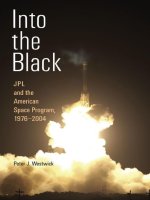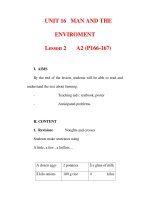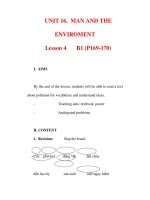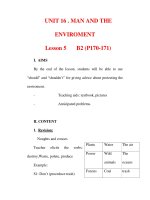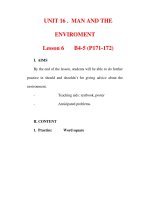4 16 cape canaveral and the kennedy space center
Bạn đang xem bản rút gọn của tài liệu. Xem và tải ngay bản đầy đủ của tài liệu tại đây (3.47 MB, 10 trang )
Fascinating Facts
• On the Apollo 11 mission, astronauts had only
two different meals to choose from.
• More than six billion people live on Earth. Fewer
than five hundred have flown into space.
• The pump on the main engine of the space
shuttle is so powerful that it can drain a
swimming pool in twenty-five seconds.
Genre
Nonfiction
Comprehension Skill
Summarize
Text Features
• Maps
• Time Line
• Captions
• Sidebar
Scott Foresman Social Studies
ISBN 0-328-14880-6
ì<(sk$m)=bei ag< +^-Ä-U-Ä-U
Cape Canaveral and the Kennedy Space
Center each have a unique place in the space
program. For decades, they have served as
the headquarters for launching hundreds of
spacecraft to learn about the mysteries of
outer space. In this book you will learn all
about the United States space program and
its triumphs.
Vocabulary
Write to It!
The old saying “The sky is the limit” means that
people can accomplish just about anything they
set their minds to. How well does this saying
apply to the work that has been done by NASA?
When it comes to space exploration, do you think
there is really a “limit”? Write a paragraph or two
explaining your reasons whether there is a limit to
space exploration and what it can accomplish.
Write your ideas on a separate sheet of paper.
cape
satellite
space race
space shuttle
space station
technology
Maps
MapQuest, Inc.
Photographs
Every effort has been made to secure permission and provide appropriate credit for photographic material.
The publisher deeply regrets any omission and pledges to correct errors called to its attention in subsequent editions.
Unless otherwise acknowledged, all photographs are the property of Scott Foresman, a division of Pearson Education.
Photo locators denoted as follows: Top (T), Center (C), Bottom (B), Left (L), Right (R), Background (Bkgd).
ISBN: 0-328-14880-6
Copyright © Pearson Education, Inc. All Rights Reserved. Printed in the
United States of America. This publication or parts thereof, may be used with appropriate
equipment to reproduce copies for classroom use only.
1 2 3 4 5 6 7 8 9 10 V0G1 14 13 12 11 10 09 08 07 06 05
Opener: ©NASA/GSFC, ©NASA
4 ©NASA
7 ©NASA
Editorial Offices: Glenview, Illinois • Parsippany, New Jersey • New York, New York
10 ©NASA
12 (B)AP/Wide World Photos,
(C) ©David
Sales
Offices:E Myers/Getty
Needham,Images
Massachusetts • Duluth, Georgia • Glenview, Illinois
13 (CR) ©Tony Freeman/PhotoEdit,
©NASA
Coppell,(BL)
Texas
• Ontario, California • Mesa, Arizona
14 ©Comstock Inc.
15 Corbis
The Space Coast
Building Cape Canaveral
Florida has about twelve hundred miles of coastline.
Many of these coasts have special nicknames, like
the Treasure Coast, the Gold Coast, and the Nature
Coast. Perhaps you and your family have driven along
the Atlantic to the east of Orlando. If so, you have
been to the Space Coast. Stretching from Palm Bay to
Titusville, this coast is home to Cape Canaveral and
the Kennedy Space Center (KSC). It is the world’s
center of space exploration.
Welcome to Florida’s Space Coast! Fasten your
seatbelts! You are about to take a wild ride into the
space age.
Cape Canaveral’s story begins in the 1940s. Across
the country, in New Mexico, the United States military
was testing rockets. After a rocket crashed, the military
knew it needed a new rocket range. Cape Canaveral,
separated from mainland Florida by the Indian River,
offered the perfect location. A cape is a point of land
extending out into the ocean. Few people lived in the
region. Rockets could be launched over the ocean. The
warm climate also allowed launches to take place
all year long. Workers constructed buildings, roads,
runways, and launch pads. In 1950 the United States
military sent up its first rocket from the new base at
Cape Canaveral.
South
Lake
CANAVERAL
NATIONAL
SEASHORE
Shuttle
Landing
Facility
Titusville
l
BCC Astronaut
Memorial
Planetarium
and Observatory
Rive
r
Visitor
Center
Merritt
Island
Lake
Poinsett
City
Place of
interest
Lake
Winder
CAPE
CANAVERAL
AIR
Cape
STATION Canaveral
Space and
Missile Museum
Port Canaveral
Cocoa
Key
Ban
a na
Port
St. John
JOHN F.
Titan IV Complex
KENNEDY Vehicle
Assembly
SPACE
Building
CENTER
t r a c o a st a
I n d ia n In a y
Waterw
Astronaut
Hall of Fame
The Early Years of Cape Canaveral
Shuttle Launch
Complex 39
Rockledge
Cape Canaveral
Cocoa
Beach
ATLANTIC
OCEAN
0
0
2
4 Miles
Spanish explorers gave Cape Canaveral its name
when they visited the area in 1513. Canaveral
means “place of the cane.” (There are several
kinds of plants in the area that look like sugar
cane.) The cape was an important landmark for
sailors, and it appears on some of Florida’s oldest
known maps. Not until the mid-1800s did the first
American settlers arrive on the cape. Over time, a
few small villages sprang up. But by the 1940s, the
population of the cape stood at only about 100.
2 4 Kilometers
S
2
3
Building Kennedy Space Center
In 1957 all eyes turned to space. The Soviet Union,
a country that was made up of Russia and other
countries, launched a satellite to orbit Earth.
Americans were shocked that they had not produced
the world’s first satellite. Only a few months later,
the United States sent up its own satellite from Cape
Canaveral. The space race had begun! For the next
few decades, the United States and the Soviet Union
competed to make the most progress in exploring
space. The two countries launched more than five
thousand spacecraft.
To run the new space program, the National
Aeronautics and Space Administration (NASA) was
established in 1958. From its base at Cape Canaveral,
NASA developed and launched spacecraft. But almost
right away, NASA started running out of room.
Officials looked around for a new launch site. They
considered many sites. White Sands, New Mexico, had
no outlet to the sea. Brownsville, Texas, was too close
to where people lived. South Point, a Hawaiian Island,
was too far away, and it would cost too much money to
build a site on it.
In the end, NASA looked in its own backyard.
Merritt Island was located just north of Cape
Canaveral, across the Banana River. NASA got to work
building a first-class spaceport, or site for launching
spacecraft. In 1965 the Kennedy Space Center officially
opened for business.
The United States launched its first satellite, Explorer 1, in 1958.
4
5
Kennedy Space Center
Today, NASA launches most of its space vehicles
with crews from the Kennedy Space Center on Merritt
Island. On Cape Canaveral, NASA and the United
States Air Force launch spacecraft without astronauts
aboard. However, to many people, the name “Cape
Canaveral” means both the cape and Merritt Island.
Let’s take a short tour of space headquarters and see
some of the highlights at Kennedy Space Center!
2
1
3
1
People come to the Visitor Complex to learn about
space exploration.
2
The Apollo/Saturn V Center serves as a tribute to the Apollo
missions that put astronauts on the moon.
3
Parts of the International Space System are assembled at the
International Space Station Center.
6
Millions of people from around the world come to
the Kennedy Space Center to learn about the space
program. Space shuttles are put together at the
Vehicle Assembly Building. It is one of the largest
buildings in the world and has eight acres of floors. The
Crawler Transporter weighs six million pounds and
travels at one mile per hour. It carries the space shuttle
from the Vehicle Assembly Building and the launch pad.
From the viewing area, visitors to KSC can watch space
shuttles lifting off from launch pads 39A and 39B. Many
of the launch pads are still being used today. Others are
historic launch pads. Teams direct all launches from
the Launch Control Center. The space shuttle lands on
the Shuttle Landing Facility as a glider. If the shuttle
lands at another NASA site, a 747 jet carries it back
to KSC. After landing, space shuttles go to the Orbiter
Processing Facilities. There they are inspected, tested,
and repaired before their next mission.
7
Astronauts, Satellites,
and Space Probes
In the early 1960s NASA set its sights on reaching
the moon. On July 20, 1969, a spacecraft finally landed
on the moon. Neil Armstrong was the first of only
twelve people—all American astronauts—to set foot on
the moon.
In 1973 NASA launched Skylab, which was the
first space station. The Skylab astronauts lived and
worked aboard the space station for 171 days. They
learned about the space environment and the needs of
humans in space.
In 1981 NASA opened a new era in space travel with
the space shuttle program. The space shuttle is the
only reusable spacecraft. Space shuttles have wings
so they can glide back to Earth on the three-mile-long
runway at the Kennedy Space Center. Astronauts
aboard the space shuttle carry out experiments and
repair satellites.
Some satellites, like the powerful Hubble Space
Telescope, are put in place by the space shuttle. It has
been orbiting Earth since 1990 and taking spectacular
pictures of planets and other heavenly objects. In 1994
Hubble captured images of a comet crashing into Jupiter.
Time Line of the Space Race
1969
1958
The United States launches
the satellite Explorer I.
1965
1959
The Soviet Union lands
Lunar 2 on the moon.
1957
1958 1959
1960
1961
On March 18 a Soviet
astronaut leaves his
spacecraft and walks
in space.
1965
1957
The Soviet Union launches
the satellite Sputnik 1.
8
1961
On April 12 the Soviets send Yuri
Gagarin into space. On May 5 NASA
sends Alan Shepard into space.
On July 20 NASA’s
Apollo 11 lands
on the moon. Neil
Armstrong and
Edwin “Buzz” Aldrin
walk on the surface
of the moon.
1969
1975
A United States spacecraft joins
together with a Soviet spacecraft. This is
the first international space flight.
1970
1972
1975
1970
1972
The Soviets
land a
spacecraft
on Venus.
The United States launches
Pioneer 10. More than a year later,
the spacecraft flies past Jupiter. In
1983 it passes Neptune.
9
Since the 1960s NASA has also been launching
space probes to take measurements and pictures of the
planets and sometimes even land. For instance, rovers,
or robot vehicles, on Mars have recently sent back
photographs of a landscape covered with rocks, craters,
and reddish-brown Martian dust.
Satellites also help scientists study the earth. Cameras
on the satellites help scientists notice important changes
on the earth, like increased water pollution.
Satellite pictures also show bizarre natural events
on the earth, and even in Florida. Images have shown
a mysterious pocket of water in Florida Bay that has
changed color from bluish-green to black. Other pictures
caught “red tides” along Florida’s coast that were caused
by dust from Africa’s Sahara Desert. If you go to the
NASA Web site, you can see these images, including
what Florida looks like from space.
The International Space Station
An ongoing NASA program is the International
Space Station, built in the 1990s. Space shuttles bring
crews to and from the space station. Aboard the space
station, astronauts carry out many experiments. They
are eager to learn more about how to keep people in
space healthy and safe.
Hundreds of people on the ground also contribute
to the program. At the International Space Center,
some workers put the space station together and test
equipment. Other workers partner with the space
programs from other countries. Astronauts also work
in this building after they have trained on models at
another NASA site, Johnson Space Center in Houston,
Texas. They come to KSC to practice working with the
actual machines and tools they will be using in space.
Then they blast off!
Some parts of the
International Space Station
are put together on the ground.
10
11
Over the years NASA technology has led to many
useful inventions that we use every day. Some of
this technology just makes doing things easier. But
sometimes it actually saves lives. Scientists from
the Kennedy Space Center have even worked with
Florida’s police department. They have made video
footage clearer and helped the police identify criminals.
Whale “Tailprints”
NASA scientists created special software, or
computer programs, to look at how space
shuttles work. Today, marine biologists
or scientists who study ocean life, use
this software to track humpback whales.
The software creates a file based on the
features of a whale’s tail. Using a database,
or collection of information, biologists can
identify the humpback whales.
Infrared Thermometer
Infrared technology first developed by
NASA has been used to create a
thermometer that measures temperature
in less than two seconds. The patient
does not even have to be awake!
12
Infrared technology has proved to be a big help to
Florida in many ways. The Florida Highway Patrol uses
laser guns that beam infrared light to catch speeding
drivers. Firefighters putting out blazes in large
buildings, such as shopping centers, use an infrared
camera placed on top of a high ladder. The pictures
from this camera let firefighters see everything that
is going on in the area. Even citrus growers use this
technology. Planes carrying infrared cameras take
pictures of groves. Computers then count the trees
and identify unhealthy ones.
Smoke Detector
NASA needed to make sure no fires broke
out on board Skylab, so scientists invented
a smoke detector. Today, most states have
passed laws that require homes to be
equipped with smoke detectors, because
they have saved so many lives.
Breathing System
If a fire breaks out on the launch pad,
rescue workers need to get on the job fast!
So NASA led the development of special
equipment for emergency rescue workers.
The new air pack was small, light, and it
helped cool the body. Today, firefighters and
other emergency workers can use this type
of air pack and increase their chances of
saving lives.
13
Astronauts aboard the
International Space
Station are working to
answer an important
question: Will humans ever
be able to live on Mars?
The Future of Space
What does the future hold for the space age? No one
can say for sure, but NASA has many plans. NASA’s
plans include sending robots and humans to explore
the moon. NASA hopes to one day explore Mars as
well. Crews aboard the International Space Station are
experimenting with growing plants in space. Plants
are necessary for life on other planets, because they
provide food and oxygen. Someday, NASA may lead the
way in space settlements.
The Kennedy Space Center is also helping other
communities and countries build spaceports. NASA
believes that in the future, people and goods will
travel by spaceflight. NASA sees a future world
in which spaceports around the globe will launch
many spacecraft each day.
14
You cannot look into the future and see what the
space age will bring, but you can look into the space
program. Today, the Kennedy Space Center opens its
doors to millions of tourists. These visitors welcome
the chance to learn more about space developments,
examine space gear, and experience the thrill of
seeing a spacecraft launch. Over the years, thousands
of people have settled in the towns along the Space
Coast. These people combine their skills to create the
space program at Kennedy Space Center. Perhaps one
day you’ll join them, as a researcher, a scientist, an
engineer, or even as an astronaut!
The crew for the space shuttle Endeavour pose
together during their training.
15
Glossary
capeCanaveral
a point of and
landthe
extending
out
into
Cape
Kennedy
Space
the ocean
Center
each have a unique place in the space
program.
they have
served
as
satelliteFor
an decades,
object launched
to orbit
Earth
theorheadquarters
for launching
hundreds of
another heavenly
body
spacecraft to learn about the mysteries of
space race an unofficial competition
outer space. In this book you will learn all
between the United States and the
about the United States space program and
Soviet Union to explore space and land
its triumphs.
on the moon
space shuttle a reusable spacecraft that
Vocabulary
can carry people
and cargo
Write to It!
The old saying “The sky is the limit” means that
people can accomplish just about anything they
set their minds to. How well does this saying
apply to the work that has been done by NASA?
When it comes to space exploration, do you think
there is really a “limit”? Write a paragraph or two
explaining your reasons whether there is a limit to
space exploration and what it can accomplish.
Write your ideas on a separate sheet of paper.
space station a human-made
structure
cape
orbiting in space that people can live in
satellite
for several months
space race
technology the use of scientific knowledge
space
shuttle
to solve practical
problems
space station
technology
Maps
MapQuest, Inc.
Photographs
Every effort has been made to secure permission and provide appropriate credit for photographic material.
The publisher deeply regrets any omission and pledges to correct errors called to its attention in subsequent editions.
Unless otherwise acknowledged, all photographs are the property of Scott Foresman, a division of Pearson Education.
Photo locators denoted as follows: Top (T), Center (C), Bottom (B), Left (L), Right (R), Background (Bkgd).
ISBN: 0-328-14880-6
Copyright © Pearson Education, Inc. All Rights Reserved. Printed in the
United States of America. This publication or parts thereof, may be used with appropriate
equipment to reproduce copies for classroom use only.
1 2 3 4 5 6 7 8 9 10 V0G1 14 13 12 11 10 09 08 07 06 05
16
Opener: ©NASA/GSFC, ©NASA
4 ©NASA
7 ©NASA
10 ©NASA
12 (B)AP/Wide World Photos, (C) ©David E Myers/Getty Images
13 (CR) ©Tony Freeman/PhotoEdit, (BL) ©NASA
14 ©Comstock Inc.
15 Corbis
